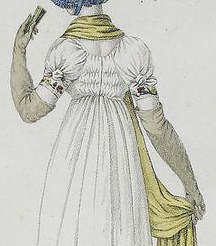
This is part two on my series to answer a lot of amazing questions from a reader about gloves and glove etiquette. Here is a link to part one.
She has quoted some sources, which I have bolded and italicized. Her comments/questions are italicized.
“…A gentleman also needed to think about what to do if he was wearing dark gloves and the woman was wearing light or white gloves. In such cases gentlemen were advised to avoid touching a woman’s hand altogether, as “dark gloves … may soil her white ones.”
All the descriptions I’ve read of men’s gloves were that they were not black. Yet they had to have black gloves. Where were black gloves used primarily? For travel? Outdoors? Ever for riding? Do the paintings/illustrations show other colors simply because of the contrast, or because black gloves were used at less fashionable places or at other times? I have many (very expensive!) references on fashion, but there is very little on men’s fashion, and what I’ve found is thin.
Black gloves were most frequently used as an expression of mourning, although also appear to come into fashion in early Victorian era with ladies’ evening wear, particularly when made from silk and likely inspired by the national mourning in the 1820s.
I think the concern over dark gloves and soiling white ones was likely to be more for yellows, greys and browns of leather. I have also read about some particular Peacocks wearing outlandish colors like purple, but I don’t think this was the norm. To be in keeping with breeches, inexpressibles, cravats, and the like I think it more likely for a gentleman to have a lighter colour glove, perhaps the exception being the driving glove (to match his greatcoat). However, in reading a bit about Woodstock (the driving glove manufacturing base of the kingdom), and the process of making gloves, my guess is that after they were tanned they were most likely dyed more natural or earth tone colours based on the dye available to them (Schulz, T. E. “The Woodstock Glove Industry.” Oxoni–ensia 3 (1938): 142.).
Illustrated and Descriptive Catalogue and Trade-Price List of India ..., 1856
I found in a lot of Victorian era publications this general advice about black gloves, which although several decades after the Regency, resonates a bit:
Godey’s Magazine, Volume 83, 1871
I have also read a couple references to black gloves being associated with trades like doctors and lawyers, so my guess is if your hero is of the gentry he likely would only be caught wearing black gloves when someone else was dead.
Pantologia: A New Cabinet Cyclopaedia, 1819
On Limerick gloves: https://janeaustensworld.wordpress.com/tag/limerick-glove/











